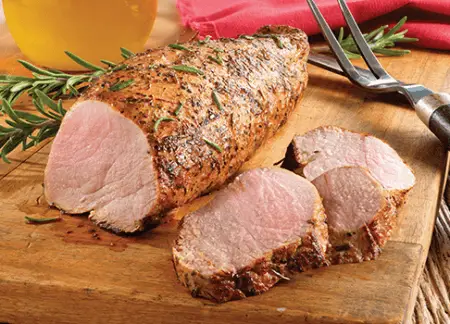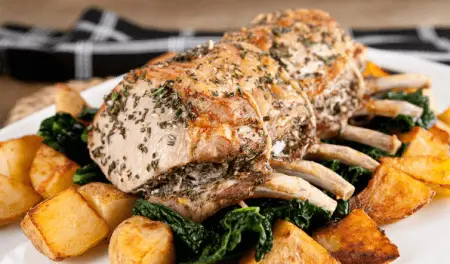A rich source of vitamins, minerals, and protein, pork loin and pork roast are terms that are often used interchangeably. But even though they bear strong associations, they are far from being the same. This article reveals the differences between the two.
Summary Table
| Pork Loin | Pork Roast |
| Refers to a primal cut of meat | Refers to the size and amount of pork ideal for roasting |
| Pertains to a specific body part of a pig | Does not pertain to a specific body part of a pig |
| Divided into 3 sections: the blades, the sirloin, and the center section | Not divided into any sections |
Definitions

Pork loin, by definition, is a cut of meat that runs along the tissue to the topmost part of the rib cage. Ideal for roasting, baking, and frying, it is the leanest and the largest primal cut of meat. Since it is the cut with the lowest fat content, it should be cooked with great care and precision because it has the tendency to easily dry out when overcooked.
The loin can either be boned or boneless. It includes the areas between the shoulders and the hind legs, which are considered the most tender parts of a pig. Because the loin is the largest primal cut, it is divided into 3 sections: the sirloin, the blades, and the center section. The sirloin is the hind part, whereas the blades are most proximal to the shoulders. The center section is located between these two areas.

Pork roast, also known as butt roast, loin roast, sirloin roast, and pork tenderloin, pertains to the size of pork ideal for roasting, rather than the specific pork cuts. Furthermore, pork roast is determined not by individual cuts but by the amount of meat sold in the market. For instance, pork loin roast typically weighs around 2 to 4 pounds, whereas tenderloin roast weighs approximately 1 pound.
Even though almost all parts of the pork can be roasted, the shoulder, butt, and loin are perfect for roasting. Pork roast can either be boned or boneless, depending on individual preferences. Boned pork roast (also known as “bone in”) still has its loin ribs intact.
Pork Loin vs Pork Roast
So what’s the difference between pork loin and pork roast? They may seem similar at first glance, but there are significant differences between the two.
Firstly, pork loin is a primal cut of meat created by cutting through the tissue to the topmost part of the rib cage. Pork roast refers to the size and amount of pork ideal for roasting.
Unlike pork roast, the loin section refers to a particular body part of a pig. The loin is an area that runs from the hind legs to the shoulders, including the upper section of the pig’s body. Since it is the largest primal cut, it is divided into 3 important parts: the sirloin, the center section, and the blade section. The blade section is located near the shoulders, while the sirloin is the hind part. The center section, as the name implies, is situated between the two.
Pork roast, on the other hand, is not a specific body part. Instead, it refers to the ideal size of pork used for roasting. The most common types of pork roast sold in the market include the loin, butt, and shoulders. Pork roast can either be boned or boneless, depending on the section used for roasting.
Calories, Protein, & Vitamins
When it comes to the calories and protein in a pork loin and a pork roast, these cuts of meat are about equal. A 3-oz serving of blade roast and a center loin provide between 22-24 grams of protein.
Both cuts of meat are also rich sources of B vitamins and zinc. B vitamins are essential to turn food into the energy your body needs, support mood, and synthesize red blood cells.
Zinc is essential for the entire body. It helps synthesize proteins and DNA (aiding in wound healing). Zinc is also essential to help improve your senses of taste and smell. Without the right amount of zinc in your diet, your immune system will also become weak.
Can You Substitute Pork Loin for Pork Roast?
No, that’s not possible. The reason is that pork loin is too lean to cook for long periods, which is needed in pork roast recipes. The meat would become too dry and not have much flavor.
On the other hand, using pork roast in a pork loin recipe also wouldn’t work well. The meat is too thick to cook through, meaning it would be raw. Raw pork is not safe for human consumption.
Alternatives to Pork Loin
Pork loin is a popular cut of pork; however, it can also be pretty expensive. But you’ll be happy to learn that there are alternatives you can consider!
You may want to consider boneless or center-cut pork chops. These are usually more on the expensive side; however, they are lower in fat. Another option is to go with a tenderloin, which is a thin, long muscle that runs across the pig’s back. This has an excellent flavor and cooks well at higher temperature cooking methods (such as roasting or searing).
Other meats to consider include:
- Turkey breast
- Chicken breast
- Beef tenderloin






